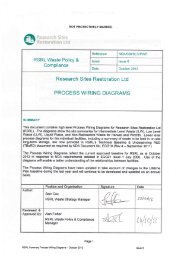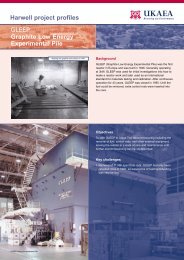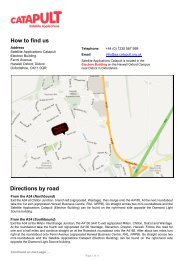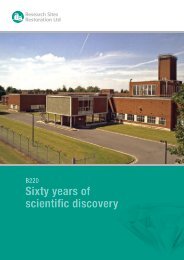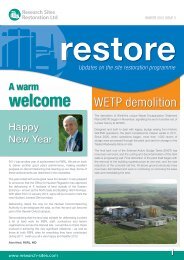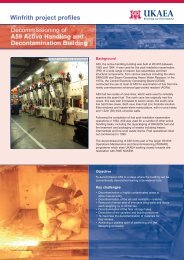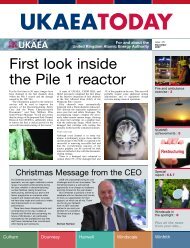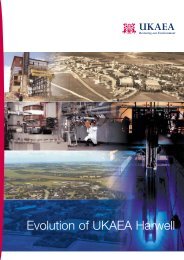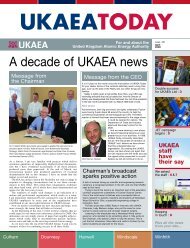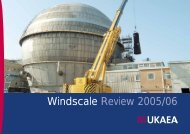RSRL Integrated Waste Strategy - Issue 5- Oct 2012.pdf
RSRL Integrated Waste Strategy - Issue 5- Oct 2012.pdf
RSRL Integrated Waste Strategy - Issue 5- Oct 2012.pdf
Create successful ePaper yourself
Turn your PDF publications into a flip-book with our unique Google optimized e-Paper software.
NOT PROTECTIVELY MARKED6.2 Radioactive Discharges6.2.1 Radioactive Liquid Discharges246. The volumes of all types of liquid effluent have decreased significantly over the past 15years as Harwell has moved from a predominantly research and development site todecommissioning and waste management as its core business.247. The strategy for the management of effluent reduction at Harwell was reviewed andrevised in 2005. A survey of arisings from the Harwell site indicated that liquid effluentcurrently received by <strong>RSRL</strong> can be considered to fall into one of three categories:• Clean effluent which cannot contain any radioactivity (<strong>RSRL</strong> buildings and facilitiesproduce inactive trade waste and foul waste, both of which are discharged to thepublic sewer)• Non-treatable active effluent which could contain very low levels of radioactivity butat levels for which treatment gives no benefit in terms of decontamination• Treatable active effluent with levels of radioactivity sufficient for decontamination tobe a viable treatment.Surface water is discharged to the Lydebank Brook248. The main sources of active effluent requiring treatment are from operations in thepressurised suit and decontamination areas of the Solid <strong>Waste</strong> Complex. Non-treatableactive effluent arises from operations in the Solid <strong>Waste</strong> Complex, Radiochemical Buildingand Active Handling Facility. There is an ongoing programme of effluent segregation inorder to reduce the volumes of effluent in each category. This constrains consignors to usethe appropriate effluent discharge route so that inactive effluent is excluded from activeeffluent streams, for example non-active “trade” effluent is discharged to the foul drain andshower effluent volumes are minimised.249. Following recent approval by Thames Water, sampled non-treatable active effluent, suchas <strong>RSRL</strong> trade waste, can now be discharged direct to the public sewer as well as via thedischarge pipeline. This follows the granting of the revised EA Radioactive SubstancesPermit for Harwell in November 2011. Discharge to the public sewer will enable thedecommissioning of the LETP and the Sutton Courtenay Discharge Pipeline to take place asplanned.250. Following the decommissioning of the Main Active Drain during 2011, treatable activeeffluent is currently transferred to the LETP via tanker, warboys or Intermediate BulkContainers. Once at the LETP it undergoes a physical/chemical treatment (flocculation)which adjusts the chemical content and removes sufficient radioactivity to discharge theresulting effluent to the River Thames via the Sutton Courtenay discharge pipeline or, aswith non-treatable active effluent, direct to the public sewer. With the reduction in thevolume of this effluent <strong>RSRL</strong> are currently commissioning a new treatment plant, known asthe Replacement Effluent Treatment Plant (RETP), which will discharge effluent direct tothe public sewer and solidify LLW sludge for disposal to LLWR. The operation of the RETPwhich will enable the existing treatment plant and discharge pipeline to the River Thames tobe decommissioned.251. In addition to the planned BPEO study mentioned above, the strategy for radioactiveliquid discharges was covered in the BPEO review carried out in 2006 at the request of EA.Radioactive liquid discharges were also included in the site waste BPEO study.<strong>RSRL</strong> IWS (<strong>Issue</strong> 5 – <strong>Oct</strong>ober 2012)72




